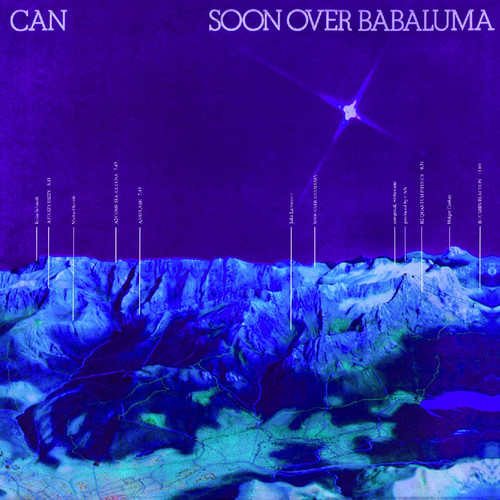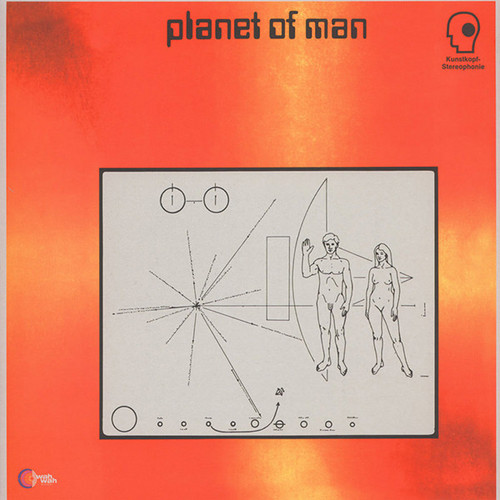Psych /
Queen Of Saba
Overshadowed by their more experimental and cosmic labelmates, Walpurgis made probably one of the most overlooked items of the Ohr catalogue... This quintet from Berlin formed by Ryszard Kalemba (guitar), Jerzy Sokolowski (guitar, vocals), George Früchtenicht (bass), Jan Sundermeyer (congas, flute) and Manfred Stadelmann (drums, vocals) were helped by the ubiquitous Jürgen Dollase (Wallenstein) on keyboards for the recording sessions of their one and only one album which taking place between May…
Drachenlieder
Formed by multi-instrumentalists Hans Reffert ('Flute') and Hans Brandeis ('Voice') in Mannheim in 1969, the Flute & Voice duo discographic debut was issued on Pilz that same year. Their second album was originally recorded in 1973, but it remained unreleased for 22 years until Jack Wieber Records issued it on CD in 1995 as part of a 2 album CD (along with Imaginations Of Light) and now available on vinyl LP format through Wah Wah. But some more material was composed in 1974/1975 and recorded, a…
Ufo
2016 repress of this 2014 reissue, the first authorized release of Hintensince its original 1971 release. German krautrock band Guru Guru was formed in 1968 as The Guru Guru Groove by Mani Neumeier (drums),Uli Trepte (bass), and Eddy Naegeli (guitar) (later replaced by AmericanJim Kennedy (guitar)). By the time of Guru Guru's debut in 1970, Ax Genrich had replaced Kennedy to solidify the classic Guru Guru line up. Guru Guru were related to the free jazz scene both through their work with Swiss p…
So Far / It's a Bit of Pain
First reissue of Faust's only 7", originally released only in Germany, France, and the UK in 1972. This reissue bears the original artwork and was remastered by Faust member Hans-Joachim Irmler from the original recordings. Both tracks are non-LP versions. It is said that "It's a Bit of Pain" was John Peel's favorite Faust track. Archive your music on vinyl! "So Far’ is an instrumental: a simple rhythm chugs along, a sax stabs away, guitars and synth wail in and out. It’s a mesmerising drone, th…
Hinten
**500 copies, transparent red vinyl** 2016 repress of this 2014 reissue, the first authorized release of Hinten since its original 1971 release. German krautrock band Guru Guru was formed in 1968 as The Guru Guru Groove by Mani Neumeier (drums),Uli Trepte (bass), and Eddy Naegeli (guitar) (later replaced by AmericanJim Kennedy (guitar)). By the time of Guru Guru's debut in 1970, Ax Genrich had replaced Kennedy to solidify the classic Guru Guru line up. Guru Guru were related to the free jazz sce…
Rastakraut Pasta
1st release from the duo of Dieter Moebius & Conny Plank, originally released on Sky Records in 1980. As the title suggests, this album is heavily influenced by dug & reggae & those rhythms are incorporated into the ambient space-rock one would expect from these German pioneers of Kosmische musik.
Imaginations of Light + Hallo Rabbit
This fine double LP release combines two full-length albums from the German acid/kraut-folk duo Flute & Voice, which was formed by Mannheim-based multi-instrumentalists Hans Reffert ('Flute') and Hans Brandeis ('Voice'). The debut-LP 'Imaginations Of Light', originally released in 1970 by the legendary Pilz label, features wonderful trippy and progressive folk music with ethnic and even jazzy elements. This LP should appeal to fans of fellow Germans s.a. Witthueser & Westrup and Bröselmaschine, …
1971-1981
Nine-CD box version. Cluster's influence on the development of electronic music cannot be overstated. The original trio of Conrad Schnitzler, Hans-Joachim Roedelius, and Dieter Moebius released two seminal albums as Kluster before Roedelius and Moebius replaced the "K" with a "C" and continued as a duo. They produced eight albums in their most innovative period between 1971 and 1981, two of them together with Brian Eno. Cluster anticipated much of what would later emerge in such varied style…
Seligpreisung
The fourth LP by Popol Vuh was originally released on Kosmische Musik in 1973. It follows the religious theme of its predecessor and features the line up of Florian Fricke with Conny Veit on guitars, Daniel Fischelscher on guitars and drums (he was the drummer of Amon Düül II), Robert Eliscu on oboe, Djong Yun on vocals and Klaus Wiesse on tamboura. Reissued from the master tapes in quality vinyl pressing, full glory laminated gatefold cover and featuring an insert with liners and photos. Limite…
Hosianna Mantra
With its religious theme it shouldn't be heretic to consider Hosianna Mantra as a small miracle. Suddenly the dark, unmelodic Popol Vuh offer us an incredibly beautiful work of amazing gothic folk that, this time, fit perfectly in the Pilz catalogue - yet managing to sound as something completely unique. It was originally released in 1972 and featured a host of musicians that included Conny Veit on guitars, Robert Eliscu on oboe, Djong Yun on vocals and Klaus Wiesse on tamboura, led of course by…
Einsjaeger & Siebenjaeger
Einsjäger & Siebenjäger, originally released on Kosmische Musik in 1974. Settling down the partnership of Florian Fricke with Daniel Fischelscher that was started in the previous outing and, again, featuring Korean soprano Djong Yun on vocals, the fifth Popol Vuh LP also counted on sporadic contributions by Olaf Kübler on flute to follow the path set on Hosianna Mantra and Seligpreisung. Reissued from the master tapes in quality vinyl pressing, full glory laminated gatefold cover and featuring p…
Affenstunde
Issued on Liberty in 1970, the debut LP by Popol Vuh features Florian Fricke's Moog synthesizer experiments at it's most spirited wild. One of the earliest experimental Moog Lps, with Fricke's electronic explorations supported at times by Holger Trülszch's percussion, flying free at others, the result has been labeled as a dark, unmelodic, unprecedented sound and it settled the path for many kraut adventurers to follow.Reissued from the master tapes in quality vinyl pressing, full glory laminate…
North Atlantic Raven
Limited numbered edition of 500. Previously unreleased album by German trio Sand, composed and recorded in 1973, '75, and '76. The once-croaking raven now flies silently over the ocean, higher and higher. Where are you rolling, sun-ball, and why don't you fall? The sandy Golem crumbled into dust. His brave struggle against the mighty forces of darkness soon dissolved in voiceless space. There is something magical and inexplicable in creation, and Sand absolutely manifest these mysterious phenome…
Ritt Durch Den Hades
Ultra-rare lost psychedelic Kraut-Folk from 1979. First time on CD and LP! Taken from the original mastertapes! Gulaab means “rose” in Nepalese language. Gulaab is a German virtuoso on the acoustic guitar who has served three years as an after dinner musician in a luxury restaurant in Nepal to play for an amazing number of well known personalities of the 20th century during the early 70s. A strongly influential experience that shaped his musical expression big time but also let him become an ope…
Planes
Wah Wah Records proudly presents a luxury vinyl reissue of this rare 1974 private pressing. Cool long electronic experiments splitted in two tracks, one on each side. Recorded in one take and offering an astounding combination of synth drones, wordless vocals, ambiental electric organ and ethereal guitar arpeggios.An outstanding work that moves away of the more classical kraut cosmische sounds to walk darker paths, yet retaining some early Kluster reminiscences.The Wah Wah reissue comes to life …
Landed
If you got a quid for each time Can were referenced as influencing a given band or artist, we'd have taken the Bank Of England down years ago. Remastered to a clarity that will come as a shock to those who've been suffering the original cd releases, 1975's 'Landed' is notable for marking the return to Can's debut line-up (barring Malcolm Mooney of course), following the love-sick Damo Suzuki's departure. Their 7th full-length release, 'Landed' also saw the band getting their mitts on a 16 track …
Soon over Babaluma
With Suzuki departed, vocal responsibilities were now split between Michael Karoli and Irmin Schmidt. Wisely, neither try to clone Mooney or Suzuki, instead aiming for their own low-key way around things. The guitarist half speaks/half whispers his lines on the opening groover, "Dizzy Dizzy," while on "Come Sta, La Luna" Schmidt uses a higher pitch that is mostly buried in the background. Holger Czukay sounds like he's throwing in some odd movie samples on that particular track, though perhaps i…
Delay 1968
Although recorded in the late '60s, the material included on Can's Delay...1968 did not appear commercially until 1981. A collection of cuts featuring early vocalist Malcolm Mooney, these seven songs are among the very first Can tunes ever recorded; while nowhere near as intricate or assured as the group's later work, the visceral energy of tracks like the deranged "Uphill" and "Butterfly" is undeniable."Along with a handful of tracks featured on Unlimited Edition, Delay represents some of Can’…
Unlimited Edition
Most bands stick out a 'unreleased and bonus bollocks' album when they're bereft of new ideas and need some filthy lucre to keep the country estate fully stocked with coy carp. You get the feeling this was the last thing on Can's mind. Having amassed a serious quantity of recordings between 1969 and '74, 'Unlimited Edition' (now giving a thorough spring-clean for this remastered release) was put out on a 15,000 only run to proceed 'Soon Over Babaluma', portraying a much rougher Can that tended n…
Planet of Man
Brothers Manfred and Wolfgang Schunke were pioneers of the Kunstkopf Stereophonie (artificial head, dummy head) binaural recording system. This recording technique was created in the Technical University of Berlin in 1974 with the aim to reproduce real stereo sound as the human ears perceive it. Human ears listen to the sounds in a concrete way that is affected not only by the sound frequencies themselves but also by the position of the listener in respect to the different sound sources. The Sch…



















